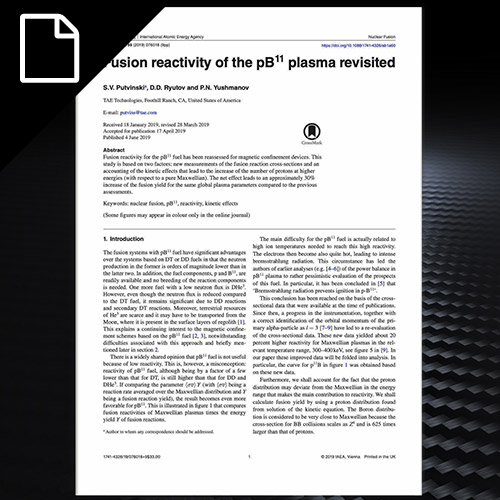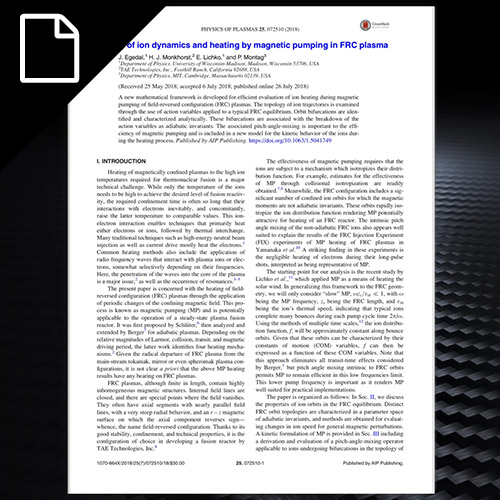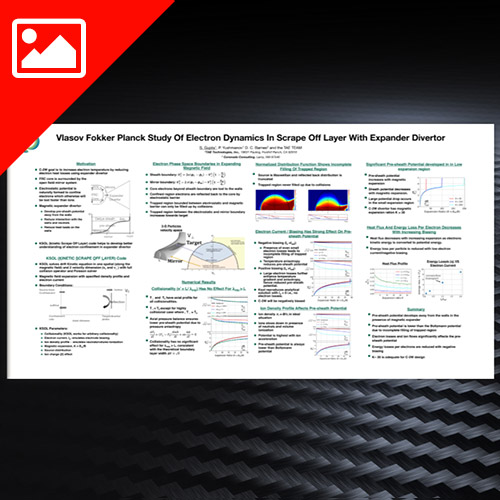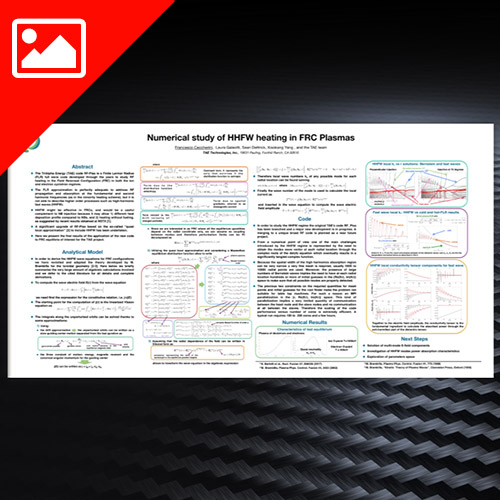Nov 2018 | Research Library, Posters, Fusion Energy, Fusion Research, Fusion Science, Fusion Technology, Modeling, Plasma Research, Simulation, Theory
October 2018 | A. Necas | APS-DPP | Poster
Spent nuclear fuel from current nuclear reactors generally managed by two distinct policies: once-through (U.S., Sw) and U/Pu recycling (Fr,J)

Oct 2018 | Research Library, Papers, Diagnostics, Fusion Energy, Fusion Research, Fusion Science, Fusion Technology, Instabilities, Modeling, Plasma Research, Theory, Top Level
October 2018 | B. Deng | Nuclear Fusion | Paper
In modern F experiments at TAE Technologies, classical FRC instabilities are suppressed
by advanced neutral beam injection and edge biasing methods, leading to high plasma confinement and fast ion pressure built-up which is comparable to the bulk plasma pressure.

Oct 2018 | Research Library, Papers, Fusion Energy, Fusion Research, Fusion Science, Fusion Technology, Modeling, Plasma Research, Theory
July 2018 | J. Egedal | Physics of Plasmas | Paper
A new mathematical framework is developed for efficient evaluation of ion heating during magnetic pumping of field-reversed configuration (FRC) plasmas. The topology of ion trajectories is examined through the use of action variables applied to a typical FRC equilibrium.

Feb 2018 | Research Library, Papers, Equilibrium, Fusion Energy, Fusion Research, Fusion Science, Fusion Technology, Modeling, Plasma Research, Theory, Transport
February 2018 | L. Steinhauer | Physics of Plasmas | Paper
Coupled transport is the close interconnection between the cross-field and parallel fluxes in differ- ent regions due to topological changes in the magnetic field. This occurs because perpendicular transport is necessary for particles or energy to leave closed field-line regions, while parallel transport strongly affects evolution of open field-line regions.

Oct 2017 | Research Library, Posters, Confinement, Edge Control, Fusion Energy, Fusion Research, Fusion Science, Fusion Technology, Plasma Research, Theory, Transport
October 2017 | S. Gupta | APS-DPP | Poster
C-2W goal is to increase electron temperature by reducing electron heat losses using expander divertor. FRC core is surrounded by the open field mirror system.

Oct 2017 | Research Library, Posters, Fusion Energy, Fusion Research, Fusion Science, Fusion Technology, Heating, Plasma Research, Theory, Waves
October 2017 | Francesco Ceccherini | APS-DPP | Poster
The Tri Alpha Energy (TAE) code RF-Pisa is a Finite Larmor Radius (FLR) full wave code developed through the years to study RF heating in the Field Reversed Configuration (FRC) in both the ion and electron cyclotron regimes.




